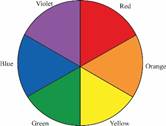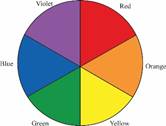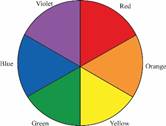
ORGANIC CHEMISTRY-STD.WILEY PLUS CARD
3rd Edition
ISBN: 9781119340515
Author: Klein
Publisher: WILEY
expand_more
expand_more
format_list_bulleted
Question
Chapter 16.12, Problem 29CC
(a)
Interpretation Introduction
Interpretation:
For each of the given tasks, the color of the compound should be determined.
Concept introduction:
- Compounds absorb visible region will have color; the absorbing color and reflecting color are complementary to each other.
- The color wheel indicates the colors and their complementary colors.

(b)
Interpretation Introduction
Interpretation:
For each of the given tasks, the color of the compound should be determined.
Concept introduction:
- Compounds absorb visible region will have color; the absorbing color and reflecting color are complementary to each other.
- The color wheel indicates the colors and their complementary colors.

(c)
Interpretation Introduction
Interpretation:
For each of the given tasks, the color of the compound should be determined.
Concept introduction:
- Compounds absorb visible region will have color; the absorbing color and reflecting color are complementary to each other.
- The color wheel indicates the colors and their complementary colors.

Expert Solution & Answer
Want to see the full answer?
Check out a sample textbook solution
Students have asked these similar questions
1,4-Dimethyl-1,3-cyclohexadiene can undergo 1,2- or 1,4-addition with hydrogen halides. (a) 1,2-Addition i. Draw the carbocation intermediate(s) formed during the 1,2-addition of hydrobromic acid to 1,4-dimethyl-1,3-cyclohexadiene. ii. What is the major 1,2-addition product formed during the reaction in (i)? (b) 1,4-Addition i. Draw the carbocation intermediate(s) formed during the 1,4-addition of hydrobromic acid to 1,4-dimethyl-1,3-cyclohexadiene. ii. What is the major 1,4-addition product formed from the reaction in (i)? (c) What is the kinetic product from the reaction of one mole of hydrobromic acid with 1,4-dimethyl-1,3-cyclohexadiene? Explain your reasoning. (d) What is the thermodynamic product from the reaction of one mole of hydrobro-mic acid with 1,4-dimethyl-1,3-cyclohexadiene? Explain your reasoning. (e) What major product will result when 1,4-dimethyl-1,3-cyclohexadiene is treated with one mole of hydrobromic acid at - 78 deg * C ? Explain your reasoning.
Give the product of the bimolecular elimination from each of the isomeric halogenated compounds.
Reaction A
Reaction B.
КОВ
CH₂
HotBu
+B+
ко
HOIBU
+Br+
Templates More
QQQ
Select Cv Templates More
Cras
QQQ
One of these compounds undergoes elimination 50x faster than the other. Which one and why?
Reaction A because the conformation needed for elimination places the phenyl groups and to each other
Reaction A because the conformation needed for elimination places the phenyl groups gauche to each other.
◇ Reaction B because the conformation needed for elimination places the phenyl groups gach to each other.
Reaction B because the conformation needed for elimination places the phenyl groups anti to each other.
Five isomeric alkenes. A through each undergo catalytic hydrogenation to give 2-methylpentane
The IR spectra of these five alkenes have the key absorptions (in cm
Compound
Compound A
–912. (§), 994 (5), 1643 (%), 3077 (1)
Compound B 833 (3), 1667 (W), 3050 (weak shoulder on C-Habsorption)
Compound C
Compound D)
–714 (5), 1665 (w), 3010 (m)
885 (3), 1650 (m), 3086 (m)
967 (5), no aharption 1600 to 1700, 3040 (m)
Compound K
Match each compound to the data presented.
Compound A
Compound B
Compound C
Compound D
Compound
Chapter 16 Solutions
ORGANIC CHEMISTRY-STD.WILEY PLUS CARD
Ch. 16.1 - Prob. 1CCCh. 16.2 - Prob. 2CCCh. 16.2 - Prob. 3CCCh. 16.2 - Prob. 4CCCh. 16.3 - Prob. 5CCCh. 16.4 - Prob. 1LTSCh. 16.4 - Prob. 6PTSCh. 16.4 - Prob. 7PTSCh. 16.4 - Prob. 8ATSCh. 16.5 - Prob. 2LTS
Ch. 16.5 - Prob. 9PTSCh. 16.5 - Prob. 10PTSCh. 16.5 - Prob. 11ATSCh. 16.5 - Prob. 12CCCh. 16.7 - Prob. 3LTSCh. 16.7 - Prob. 13PTSCh. 16.7 - Prob. 14ATSCh. 16.7 - Prob. 15CCCh. 16.7 - Prob. 16CCCh. 16.7 - Prob. 17CCCh. 16.7 - Predict the regiochemical outcome (major product)...Ch. 16.8 - Prob. 19CCCh. 16.9 - Prob. 20CCCh. 16.9 - Prob. 4LTSCh. 16.9 - Prob. 21PTSCh. 16.9 - Prob. 22ATSCh. 16.10 - Prob. 23CCCh. 16.10 - Prob. 24CCCh. 16.10 - Prob. 25CCCh. 16.10 - Prob. 26CCCh. 16.11 - Prob. 5LTSCh. 16.11 - Prob. 27PTSCh. 16.11 - Prob. 28ATSCh. 16.12 - Prob. 29CCCh. 16 - Prob. 30PPCh. 16 - Prob. 31PPCh. 16 - Prob. 32PPCh. 16 - Prob. 33PPCh. 16 - Prob. 34PPCh. 16 - Prob. 35PPCh. 16 - Prob. 36PPCh. 16 - Prob. 37PPCh. 16 - Prob. 38PPCh. 16 - Prob. 39PPCh. 16 - Prob. 40PPCh. 16 - Prob. 41PPCh. 16 - Prob. 42PPCh. 16 - Prob. 43PPCh. 16 - Prob. 44PPCh. 16 - Prob. 45PPCh. 16 - Prob. 46PPCh. 16 - Prob. 47PPCh. 16 - Prob. 48PPCh. 16 - Prob. 49PPCh. 16 - Prob. 50PPCh. 16 - Prob. 51PPCh. 16 - Prob. 52PPCh. 16 - Prob. 53PPCh. 16 - Prob. 54PPCh. 16 - Prob. 55PPCh. 16 - Prob. 56PPCh. 16 - Prob. 57PPCh. 16 - Prob. 58PPCh. 16 - Prob. 59PPCh. 16 - Prob. 60IPCh. 16 - Prob. 61IPCh. 16 - Prob. 62IPCh. 16 - Prob. 63IPCh. 16 - Prob. 64IPCh. 16 - Prob. 65IPCh. 16 - Prob. 66IPCh. 16 - Prob. 67IPCh. 16 - Prob. 68IPCh. 16 - Prob. 69IPCh. 16 - Prob. 70IPCh. 16 - Prob. 71IPCh. 16 - Prob. 72IPCh. 16 - Prob. 73IPCh. 16 - Prob. 74IPCh. 16 - Prob. 76IPCh. 16 - Prob. 77CPCh. 16 - Prob. 78CPCh. 16 - Prob. 79CPCh. 16 - Prob. 80CPCh. 16 - Prob. 81CP
Knowledge Booster
Similar questions
- 7. The three sets of replicate results below were accumulated for the analysis of the same sample. Pool these data to obtain the most efficient estimate of the mean analyte content and the standard deviation. Lead content/ppm: Set 1 Set 2 Set 3 1. 9.76 9.87 9.85 2. 9.42 9.64 9.91 3. 9.53 9.71 9.42 9.81 9.49arrow_forwardDraw the Zaitsev product famed when 2,3-dimethylpentan-3-of undergoes an El dehydration. CH₂ E1 OH H₁PO₁ Select Draw Templates More QQQ +H₂Oarrow_forwardComplete the clean-pushing mechanism for the given ether synthesia from propanol in concentrated sulfurica140°C by adding any mining aloms, bands, charges, nonbonding electron pairs, and curved arrows. Draw hydrogen bonded to cayan, when applicable. ore 11,0 HPC Step 1: Draw curved arrows Step 2: Complete the intend carved Q2Q 56 QQQ Step 3: Complete the intermediate and add curved Step 4: Modify the structures to draw the QQQ QQQarrow_forward
- 6. In an experiment the following replicate set of volume measurements (cm3) was recorded: (25.35, 25.80, 25.28, 25.50, 25.45, 25.43) A. Calculate the mean of the raw data. B. Using the rejection quotient (Q-test) reject any questionable results. C. Recalculate the mean and compare it with the value obtained in 2(a).arrow_forwardA student proposes the transformation below in one step of an organic synthesis. There may be one or more reactants missing from the left-hand side, but there are no products missing from the right-hand side. There may also be catalysts, small inorganic reagents, and other important reaction conditions missing from the arrow. • Is the student's transformation possible? If not, check the box under the drawing area. • If the student's transformation is possible, then complete the reaction by adding any missing reactants to the left-hand side, and adding required catalysts, inorganic reagents, or other important reaction conditions above and below the arrow. • You do not need to balance the reaction, but be sure every important organic reactant or product is shown. + T G OH де OH This transformation can't be done in one step.arrow_forwardMacmillan Leaming Draw the major organic product of the reaction. 1. CH3CH2MgBr 2. H+ - G Select Draw Templates More H о QQarrow_forward
- Draw the condensed structure of 3-hydroxy-2-butanone. Click anywhere to draw the first atom of your structure.arrow_forwardGive the expected major product of reaction of 2,2-dimethylcyclopropane with each of the following reagents. 2. Reaction with dilute H₂SO, in methanol. Select Draw Templates More CHC Erase QQQ c. Reaction with dilute aqueous HBr. Select Drew Templates More Era c QQQ b. Reaction with NaOCH, in methanol. Select Draw Templates More d. Reaction with concentrated HBr. Select Draw Templates More En a QQQ e. Reaction with CH, Mg1, then H*, H₂O 1. Reaction with CH,Li, then H', H₂Oarrow_forwardWrite the systematic name of each organic molecule: structure O OH OH name X ☐arrow_forward
- Macmillan Learning One of the molecules shown can be made using the Williamson ether synthesis. Identify the ether and draw the starting materials. А со C Strategy: Review the reagents, mechanism and steps of the Williamson ether synthesis. Determine which of the molecules can be made using the steps. Then analyze the two possible disconnection strategies and deduce the starting materials. Identify the superior route. Step 6: Put it all together. Complete the two-step synthesis by selecting the reagents and starting materials. C 1. 2. Answer Bank NaH NaOH NaOCH, снен, сен, он Сиси, Сне (СН), СОН (Сн, Свarrow_forwardWrite the systematic name of each organic molecule: structure CH3 O CH3-CH-CH-C-CH3 OH HV. CH3-C-CH-CH2-CH3 OH CH3 O HO—CH, CH–CH—C CH3 OH 오-오 name X G ☐arrow_forwardHI Organic Functional Groups Predicting the reactants or products of esterification What is the missing reactant in this organic reaction? HO OH H +回 + H₂O 60013 Naomi V Specifically, in the drawing area below draw the skeletal ("line") structure of R. If there is more than one reasonable answer, you can draw any one of them. If there is no reasonable answer, check the No answer box under the drawing area. No answer Click and drag to start drawing a structure. Explanation Check 1 2 #3 $ 4 2025 % ala5 'a :☐ G & 67 8 Ar K enter Accessible 9 Q W E R TY U 1 tab , S H J Karrow_forward
arrow_back_ios
SEE MORE QUESTIONS
arrow_forward_ios
Recommended textbooks for you
 ChemistryChemistryISBN:9781305957404Author:Steven S. Zumdahl, Susan A. Zumdahl, Donald J. DeCostePublisher:Cengage Learning
ChemistryChemistryISBN:9781305957404Author:Steven S. Zumdahl, Susan A. Zumdahl, Donald J. DeCostePublisher:Cengage Learning ChemistryChemistryISBN:9781259911156Author:Raymond Chang Dr., Jason Overby ProfessorPublisher:McGraw-Hill Education
ChemistryChemistryISBN:9781259911156Author:Raymond Chang Dr., Jason Overby ProfessorPublisher:McGraw-Hill Education Principles of Instrumental AnalysisChemistryISBN:9781305577213Author:Douglas A. Skoog, F. James Holler, Stanley R. CrouchPublisher:Cengage Learning
Principles of Instrumental AnalysisChemistryISBN:9781305577213Author:Douglas A. Skoog, F. James Holler, Stanley R. CrouchPublisher:Cengage Learning Organic ChemistryChemistryISBN:9780078021558Author:Janice Gorzynski Smith Dr.Publisher:McGraw-Hill Education
Organic ChemistryChemistryISBN:9780078021558Author:Janice Gorzynski Smith Dr.Publisher:McGraw-Hill Education Chemistry: Principles and ReactionsChemistryISBN:9781305079373Author:William L. Masterton, Cecile N. HurleyPublisher:Cengage Learning
Chemistry: Principles and ReactionsChemistryISBN:9781305079373Author:William L. Masterton, Cecile N. HurleyPublisher:Cengage Learning Elementary Principles of Chemical Processes, Bind...ChemistryISBN:9781118431221Author:Richard M. Felder, Ronald W. Rousseau, Lisa G. BullardPublisher:WILEY
Elementary Principles of Chemical Processes, Bind...ChemistryISBN:9781118431221Author:Richard M. Felder, Ronald W. Rousseau, Lisa G. BullardPublisher:WILEY

Chemistry
Chemistry
ISBN:9781305957404
Author:Steven S. Zumdahl, Susan A. Zumdahl, Donald J. DeCoste
Publisher:Cengage Learning

Chemistry
Chemistry
ISBN:9781259911156
Author:Raymond Chang Dr., Jason Overby Professor
Publisher:McGraw-Hill Education

Principles of Instrumental Analysis
Chemistry
ISBN:9781305577213
Author:Douglas A. Skoog, F. James Holler, Stanley R. Crouch
Publisher:Cengage Learning

Organic Chemistry
Chemistry
ISBN:9780078021558
Author:Janice Gorzynski Smith Dr.
Publisher:McGraw-Hill Education

Chemistry: Principles and Reactions
Chemistry
ISBN:9781305079373
Author:William L. Masterton, Cecile N. Hurley
Publisher:Cengage Learning

Elementary Principles of Chemical Processes, Bind...
Chemistry
ISBN:9781118431221
Author:Richard M. Felder, Ronald W. Rousseau, Lisa G. Bullard
Publisher:WILEY